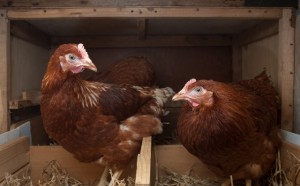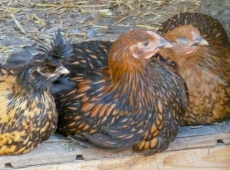Natural Behaviour
 One of our key principles is based around providing conditions that enable birds to perform their natural behaviours. In this section we consider current knowledge on a number of different behavioural aspects and how these impact on the way we should manage poultry.
One of our key principles is based around providing conditions that enable birds to perform their natural behaviours. In this section we consider current knowledge on a number of different behavioural aspects and how these impact on the way we should manage poultry.
Nesting behaviour
With regard to nesting behaviour, in the wild a hen usually moves away from the rest of the flock to find a secluded nesting place. It is unclear whether this is to prevent predation and disturbance, or as protection against weather conditions. Domestic hens, even with access to isolated nests and outdoor conditions, tend to lay close to their flock-mates rather than in isolation (Appleby et al, 1984). It is unclear why this is different to natural nesting behaviour. They may do this as a means of achieving protection or shelter, or out of habit (Lundberg and Keeling, 1999).
Within the flock hierarchical structure, subordinate hens are often bullied, particularly when seeking nest boxes (Freire et al, 1998). Lundberg and Keeling (1999) showed that social factors, and the restriction of these, have an impact on the period of time a hen spends nesting.
For more see Housing
Dust baths
It has been demonstrated that dustbathing reduces the amount of feather lipids, thereby increasing the insulation capacity of the plumage. Other suggested functions, such as control of ectoparasites, have not been proven. Dustbathing shows a clear diurnal rhythm and under unrestricted conditions, hens dust bathe about every 2 days. Birds deprived of litter show a rebound in dustbathing behaviour when litter is again made available, which suggests increased motivation after deprivation. A suitable substrate is an important stimulus for eliciting dustbathing. Hens seem to prefer substrates with a fine structure such as sand and peat (Olsson and Keeling, 2005)
Perching
 Perching, particularly at dusk, is also a strongly motivated behaviour pattern (Appleby et al., 1992). For more on perches see Housing.
Perching, particularly at dusk, is also a strongly motivated behaviour pattern (Appleby et al., 1992). For more on perches see Housing.
Rest and sleep
The main pattern of rest and sleep in poultry is set by the light-dark cycle. Chickens are generally inactive at night and the strength of the natural diurnal rhythm is enhanced if houses are completely dark at night. Birds also rest during daytime, and this is normally synchronised within a group (Appleby et al., 1992); hence the importance of allowing social grouping in promoting “natural” behaviour. Hens are motivated to perform night-time perching, and they become unsettled if there is no perch site available to them (Olsson and Keeling, 2002).
For more on lighting see Housing.
Ranging Behaviour
Visit the page on Outdoor Ranging for information on encouraging birds to free-range.


 American English
American English

Comments are closed.